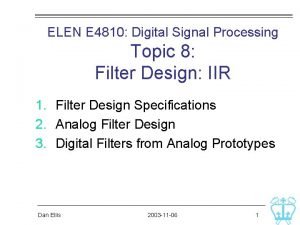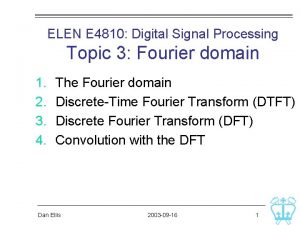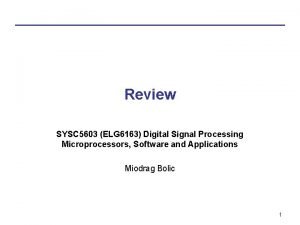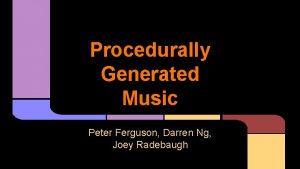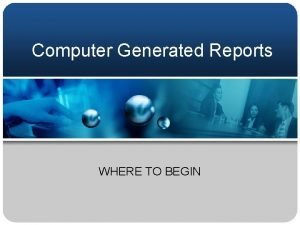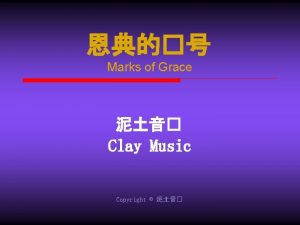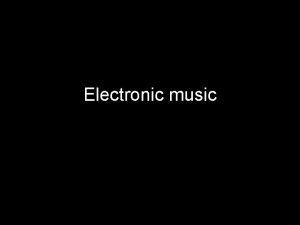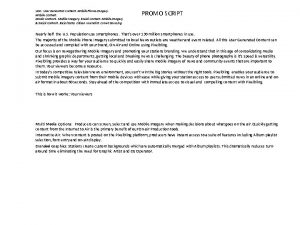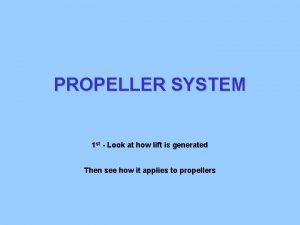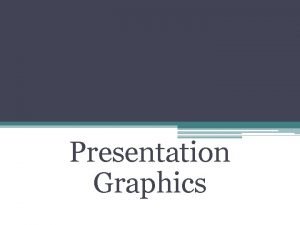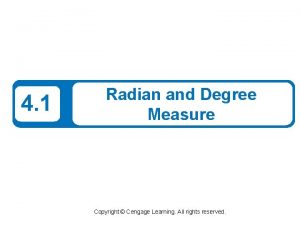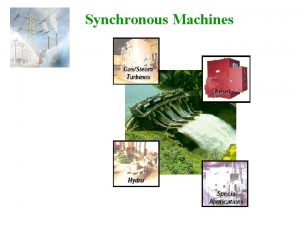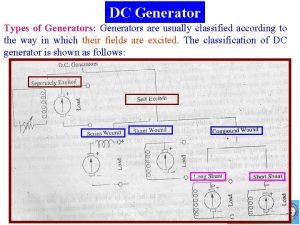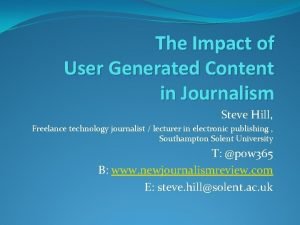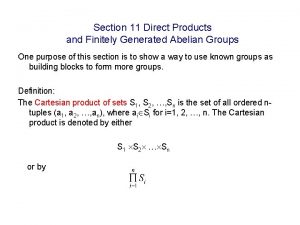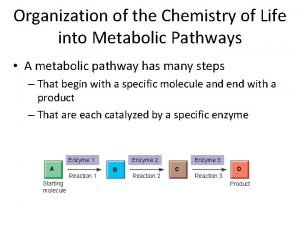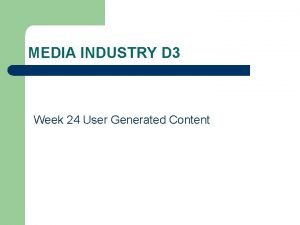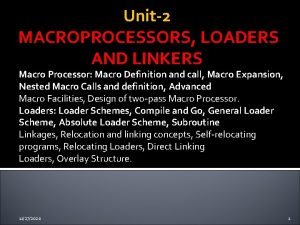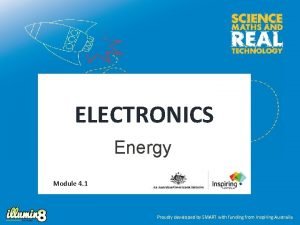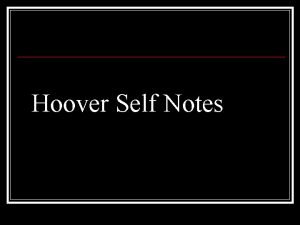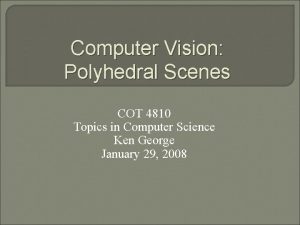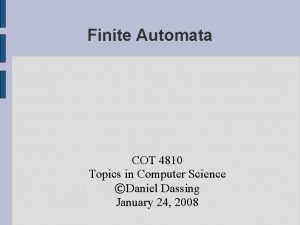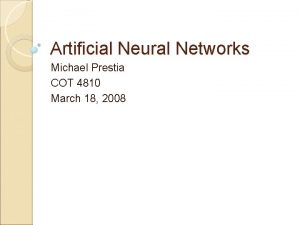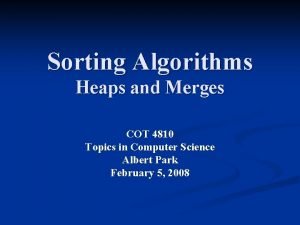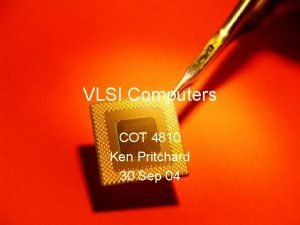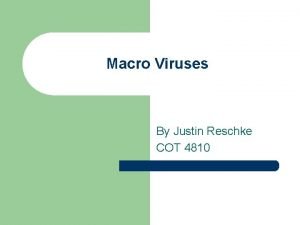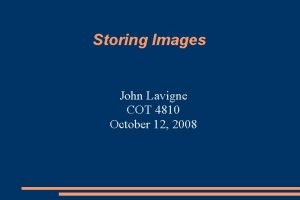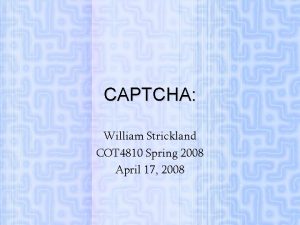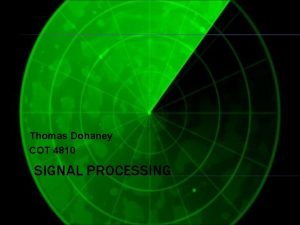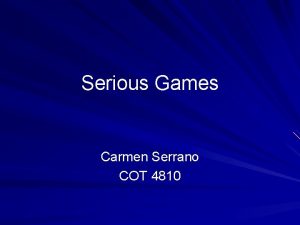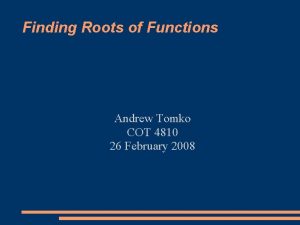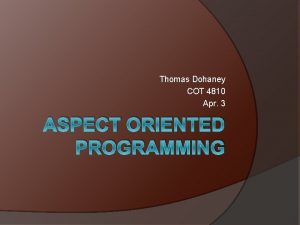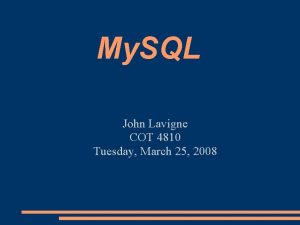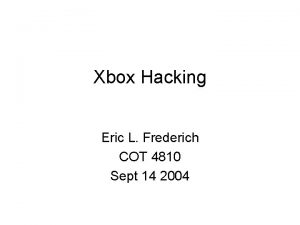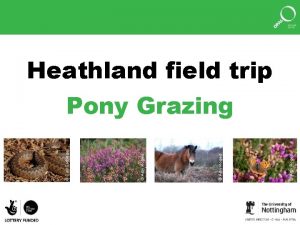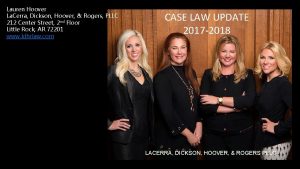Computer Generated Music Amy Hoover COT 4810 041908
























- Slides: 24

Computer Generated Music Amy Hoover COT 4810 04/19/08

Introduction • Computer-generated music sounds artificial • Current systems battle between: – Knowledge-based approaches • Prescreen song for goodness based on “known musical rules” • Sound trite, uninspired, unoriginal – Other approaches • Allow for more novelty • Sound messy, uncollected

Outline • Representing music • Deciding what is “good” • Problems

Representation • Representation: What is the best way to encode music? – How do we as programmers design a structure to represent music – Intuitive answer: Should music be represented by musical rules and encodings? – Less obvious • Functional relationships through Compositional Pattern Producing Networks (CPPNS)a

Representation: Mathematical Models • Probabilities – Idea: Actual musical notes distributed with certain probability, model with computer program – Without computer: Earliest music generation form (Mozart, Xenakis, Schoenberg) – With computer: Iliac Suite by Hiller and Isaacson (1947)

Representation: Mathematical Models • Probabilities – Idea: Actual musical notes distributed with certain probability, model with computer program Probabilities: A =. 60 B =. 40

Representation: Mathematical Models • Probabilities – Idea: Actual musical notes distributed with certain probability, model with computer program Probabilities: A =. 60 B =. 40 A B A A B

Representation: Markov Chains • Markov chain: “Conditional probability systems where the probability of future events depends on one or more past events” • Probability chart/state transition matrix • E. g. C D E F C 0. 2 0. 1 0. 3 0. 4 D 0. 5 0. 1 0. 2 E 0. 5 0. 2 0. 1 0. 2 F 0. 2 0. 3 0. 2

Representation: Markov Chains • Probability of A following B (P(A|B)) = 0 • Probability of B following A (P(B|A)) =. 5 A B B

Representation: Grammars • Idea: Music and language share similar origin – Relates sentence composition to music composition – Musical -> linguistic relations • Notes -> words • Phrases -> sentences • Melodies ->paragraphs

Representation: Grammars • E. g. – Grammar description – – In: The interval between two notes (5 th, 4 th, etc) Dn: Direction of interval SEQn: Sequence SIMn: Simultaneity • Example generative rule for this grammar – SIM 1 -> SEQ 1 +SEQ 2 – SEQ 1 -> (I 5, D 1) + (I 8, D 1) + (I 11, D 1) – SEQ 2 -> (I 5, D 2) + (I 8, D 2)

Representation: Grammars SIM 1 SEQ 2 (I 5, D 1) (I 8, D 1) (I 11, D 1) (I 5, D 2) (I 8, D 2)

Representation: Neural Networks • Idea: Artificial neural networks abstractions of human brain, can “learn” music by example • Outputs – Pitch, timbre, duration • Network structure: – Recurrent – Compositional Pattern Producing Networks (CPPNs)

Representation: Neural Networks • E. g. – Network encodes note A on the Piano. 21 Pitch node -> Pitch Map Example Timbre Map Example A <=. 33 Bass <=. 33<B<=. 67. 33<Guitar<=. 67<C<=1 . 67<Piano<=1 . 89 <- Timbre map

Determining Goodness: Critic • Idea: Generated music sounds good, neutral, or bad • Critic: Agent to distinguish good and bad – Human – Rule-based – Learning – Evolved

Critic Types: Rule Based • Idea: Music mutated by good, musically sound rules • Given set of melodies, mutate according to musical rules such as – transposition, retrograde, inversion, augmentation • Typically brittle • Confined to style • No room for composers to break the rules – (Even dissonant chords can be resolved!)

Critic Types: Human • Individual/Group • Preserve novelty • Interactive Evolutionary Computation (IEC) – User presented with population – User chooses good individuals – Good individuals parent next generation

Critic Types: Example • Gen. Jam – Generates jazz solos to “trade fours” with Biles – Jazz solo genomes are human evaluated as good or bad by a person – Winning genome accompanies Biles in real time

Critic Types: Human • Problems and Concerns – – Truly creative? User unreliability User fatigue/ Human bottleneck Many-to-one, obfuscates style

Critic Types: Learning-Based • Critics trained with “good” music • Learns to make “good” compositional decisions • Benefits: – A priori knowledge not necessary – Avoids human bottleneck • Disadvantages – Often over trains, does not generalize well

Open Problems in Evolutionary Music • Problem 1: – Current system designs are not recognized for artistic contributions • Problem 2: – Theories behind music/art systems are weak or non-existant

Conclusion • Computer generated music: Sounds artificial • Representation systems – – Probability Markov Chains Formal grammars Neural Networks • Critic types – Human – Ruled-based

Questions • 1. Name two musical representation designs • 2. What kind of critic does Gen. Jam use?

References • Bently, Peter J. , David W. Crone. Creative Evolutionary Systems. Academic Press, 2002. • Miranda, Eduardo Reck. Composing Music with Computers. Focal Press, 2001. • Miranda, Eduardo Reck, Al Biles. Evolutionary Computer Music. Springer-Verlag London, 2007. • Todd, Peter M. , Gareth Loy. Music and Connectionism. MIT Press, 1991. • Todd, Peter M. and Gregory M. Werner. Frankensteinian Methods for Evolutionary Music Composition. MIT Press, 1998.
 Elen 4810
Elen 4810 Elen 4810
Elen 4810 Sysc 4810
Sysc 4810 Online music portfolio
Online music portfolio Procedurally generated music
Procedurally generated music Computer generated report
Computer generated report Amy sand clay music
Amy sand clay music Very romantic music
Very romantic music Monophonic texture
Monophonic texture Music that employs electronic music
Music that employs electronic music Musical form of pamulinawen
Musical form of pamulinawen User generated content mobile
User generated content mobile Propeller helix angle
Propeller helix angle Presentation graphics program
Presentation graphics program What is the angle generated by a clockwise rotation?
What is the angle generated by a clockwise rotation? Difference between alternator and synchronous motor
Difference between alternator and synchronous motor Dc generator types
Dc generator types User generated content journalism
User generated content journalism Find all abelian groups (up to isomorphism) of order 360.
Find all abelian groups (up to isomorphism) of order 360. How is thermal energy generated
How is thermal energy generated Image by generated photos
Image by generated photos Rld cards contain
Rld cards contain Electric current is generated due to
Electric current is generated due to Kesler science electromagnetic spectrum answer key
Kesler science electromagnetic spectrum answer key How a battery works diagram
How a battery works diagram
